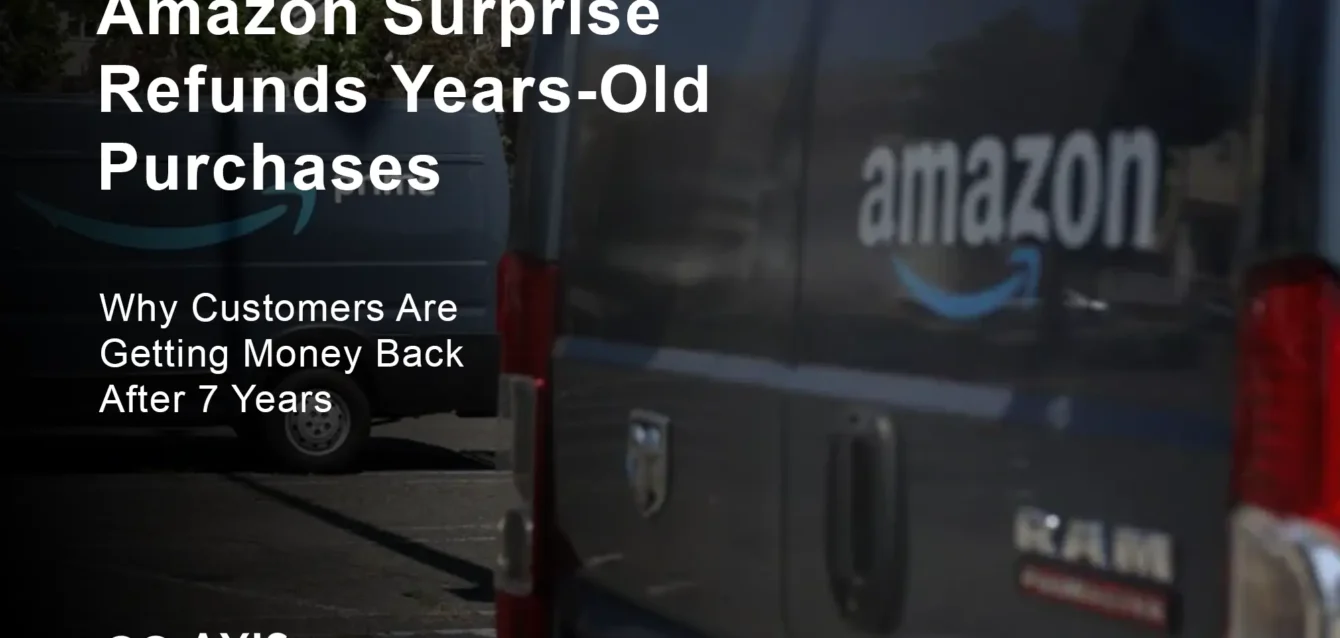Amazon Surprise Refunds Years-Old Purchases 2025
Imagine opening your email to discover Amazon owes you nearly $1,800 for something you returned seven years ago. That’s exactly what happened to Steven Pope and thousands of other Amazon customers in 2025, as the retail giant quietly began resolving what they call “unresolved returns” with automatic refunds.
Amazon has started issuing refunds to customers for returns dating as far back as 2018, with some customers receiving hundreds or even thousands of dollars. This unprecedented move affects a subset of Amazon’s massive customer base and could potentially impact millions of shoppers who made returns in recent years.
Table of Contents
- What Are Amazon’s Surprise Refunds?
- Why Is Amazon Issuing These Refunds Now?
- The Financial Impact: A $1.1 Billion Charge
- How to Check If Amazon Owes You Money
- What Types of Returns Qualify for Refunds
- The Legal Context: Class Action Lawsuits
- Amazon’s Official Response and Policy Changes
- How Refunds Are Being Processed
- What to Do If You Haven’t Received a Refund
- Red Flags: Signs Your Return Wasn’t Properly Processed
- Understanding Amazon’s Return Policy Changes
- Timeline: When These Issues Started
What Are Amazon’s Surprise Refunds?
Amazon’s surprise refunds represent a systematic effort to resolve what the company terms “unresolved returns” – purchases that customers returned but never received proper refunds for. These refunds cover products returned as far back as 2018, with Amazon identifying cases where they couldn’t verify that the correct item had been sent back or where refund payments never properly completed.
The scale of this initiative is staggering. One customer, Steven Pope, received a $1,798.81 refund for a TV he returned in 2018, while others have reported refunds ranging from a few dollars to several hundred dollars.
What Makes These Refunds “Surprise”?
These refunds are considered surprises because:
- Customers received no prior notification about pending refunds
- Many customers had forgotten about these old returns
- Amazon proactively identified and resolved these issues without customer complaints
- The refunds arrived years after the original return was made
Why Is Amazon Issuing These Refunds Now?
The timing of these refunds isn’t coincidental. Several factors have converged to push Amazon toward this unprecedented action:
Internal Review Process
Amazon states they conducted a “recent internal review” that identified a “very small subset of returns that were unresolved because we could not verify that the correct item had been sent back to us”. This review appears to have been comprehensive, spanning several years of return data.
Legal Pressure
The refunds coincide with ongoing class action lawsuits against Amazon. Holly Jones Clark of Kentucky filed a lawsuit in 2023 alleging that Amazon systematically failed to issue refunds even when items were properly returned within the 30-day window. While Amazon hasn’t directly linked the refunds to the lawsuit, the timing suggests a connection.
Regulatory Scrutiny
With increased scrutiny from regulators and consumer protection agencies, Amazon may be taking proactive steps to address potential compliance issues before they become larger problems.
The Financial Impact: A $1.1 Billion Charge
Amazon’s CFO Brian Olsavsky revealed during the company’s first-quarter earnings call that Amazon took a one-time charge of approximately $1.1 billion, related in part to “some historical customer returns” that were unresolved. While this charge also includes costs related to tariff preparation, the returns component represents hundreds of millions of dollars.
This massive financial commitment demonstrates the scope of the issue. For context, $1.1 billion represents a significant portion of Amazon’s quarterly profits, indicating that unresolved returns affected far more customers than initially apparent.
Breaking Down the Numbers
To put this in perspective:
- Amazon’s 2024 revenue was $638 billion
- The $1.1 billion charge represents roughly 0.17% of annual revenue
- This suggests millions of customers may have been affected by return processing issues
How to Check If Amazon Owes You Money
If you’ve made returns to Amazon in recent years, you might be owed money. Here’s how to check:
Method 1: Check Your Email
Amazon is automatically notifying affected customers via email. The email explains that customers are being contacted “about an unresolved product return” and that refunds are being processed automatically.
Look for emails with subject lines mentioning:
- “Unresolved product return”
- “Amazon refund”
- “Return refund processed”
Method 2: Review Your Amazon Account
- Log into your Amazon account
- Navigate to “Your Orders”
- Look for orders marked with refund status updates
- Check your payment method for recent credits from Amazon
Method 3: Monitor Your Payment Methods
Check your:
- Credit card statements for Amazon credits
- Bank account for direct deposits from Amazon
- Amazon gift card balance for unexpected additions
Method 4: Use Amazon’s Refund Tracking Tools
Amazon provides several tools to track refunds:
- Go to “Your Orders” and select “View Return/Refund Status”
- Check “Your Transactions” for a complete refund history
- Use the Amazon Returns Center to review past returns
What Types of Returns Qualify for Refunds
Not all Amazon returns qualify for these surprise refunds. Based on Amazon’s communications, qualifying returns typically involve:
Unverified Returns
Returns where Amazon “could not verify that the correct item had been sent back” to their facilities. This often occurred when:
- Items were lost in transit back to Amazon
- Returned items were misplaced at Amazon facilities
- Return tracking showed delivery but Amazon couldn’t locate the item
Incomplete Payment Processing
Cases where customers thought they received refunds, but the payment processing never completed on Amazon’s end. This technical glitch affected customers who:
- Received refund confirmations but never saw the money
- Had refunds reversed without explanation
- Experienced payment processing errors
Communication Failures
Amazon acknowledges they “could have notified these customers more clearly (and earlier) to better understand the status and help us resolve the return”. This category includes situations where customers weren’t properly informed about:
- Return status updates
- Missing documentation requirements
- Resolution options for problematic returns
The Legal Context: Class Action Lawsuits
Amazon’s refund initiative occurs amid significant legal challenges to their return policies.
The Holly Jones Clark Lawsuit
Filed in U.S. District Court for the Western District of Washington, this class action lawsuit accuses Amazon of systematically failing to issue refunds even when items were properly returned within the 30-day window. The lawsuit alleges that Amazon:
- Reversed instant refunds without proper justification
- Failed to issue refunds for properly returned items
- Forced customers to monitor their bank statements to catch missing refunds
Case Consolidation
Three separate class action lawsuits against Amazon regarding return policies have been consolidated into a single case titled “In re: Amazon Return Policy Litigation”. This consolidation suggests the scope of the problem extends beyond individual cases.
Legal Standards and Consumer Protection
The lawsuits cite violations of:
- State consumer protection laws
- Breach of contract claims
- Unjust enrichment allegations
- Conversion claims
Amazon’s Official Response and Policy Changes
Amazon’s response to these issues has been multifaceted:
Official Statement
Amazon spokesperson Maxine Tagay stated: “There is no action required from customers to receive the refunds, and we have fixed the payment issue and made process changes to more promptly contact customers about unresolved returns going forward”.
Policy Improvements
Amazon has implemented several changes:
- Enhanced return tracking systems
- Improved customer communication protocols
- Better verification processes for returned items
- Automated refund processing improvements
Proactive Resolution Approach
Rather than waiting for customer complaints, Amazon has chosen to err on the side of customers. The company states: “Given the time elapsed, we’ve decided to err on the side of customers and just complete refunds for these returns”.
How Refunds Are Being Processed
Amazon is processing these refunds automatically, with specific procedures depending on the original payment method:
Credit Card Refunds
For purchases made with credit cards:
- Refunds typically appear within 3-5 business days
- Credits show as “Amazon.com” on statements
- Amazon attempts to refund to the original payment method first
Gift Card Credits
When original payment methods are unavailable:
- Refunds are applied as Amazon Gift Card credits to customer accounts
- Credits appear automatically without customer action
- No expiration date on these special refund credits
Bank Account Refunds
For customers using bank transfers or Amazon Pay:
- Direct deposits may take 5-10 business days
- Refunds appear as electronic transfers from Amazon
- Customer banking information must be current and valid
What to Do If You Haven’t Received a Refund
If you believe you should have received a surprise refund but haven’t, here are your options:
Review Your Return History
Start by conducting a thorough review:
- Log into your Amazon account
- Go to the Returns Center
- Review returns from 2018-2024
- Check the status of each return
- Compare returns with refunds received
Contact Amazon Customer Service
If you identify potentially unresolved returns:
- Contact Amazon through their customer service portal
- Provide specific order numbers and return details
- Explain that you believe your return wasn’t properly processed
- Reference the surprise refund initiative
Use the A-to-z Guarantee
For unresolved refund issues, customers can “submit an A-to-z Guarantee refund appeal within 30 days of the original decision” and provide additional supporting information.
Document Everything
Keep detailed records of:
- Original purchase receipts
- Return tracking numbers
- Communication with Amazon
- Bank/credit card statements
- Screenshots of your Amazon account
Red Flags: Signs Your Return Wasn’t Properly Processed
Watch for these warning signs that suggest your return may not have been properly processed:
Financial Red Flags
- You received a refund confirmation but never saw the money
- Your account was charged again weeks or months after a return
- Partial refunds without explanation
- Gift card credits instead of original payment method refunds
Communication Red Flags
- No return confirmation emails
- Contradictory status updates
- Long delays in return processing
- Requests for additional documentation months after returns
Account Red Flags
- Returns showing as “pending” indefinitely
- Orders marked as “delivered” when they were returned
- Inconsistent return statuses across different Amazon interfaces
Understanding Amazon’s Return Policy Changes
Amazon’s current return policy and recent changes are crucial to understand:
Standard Return Window
Most items can be returned for a refund within 30 days of delivery as long as they are in original or unused condition. However, the surprise refunds suggest this policy wasn’t always properly implemented.
Processing Timeframes
Amazon states it can take up to 30 days to receive and process returns, with additional time for financial institutions to make funds available. The surprise refunds reveal that some returns took much longer to process.
Non-Returnable Items
Certain products cannot be returned, including:
- Items marked as “Final Sale”
- Products under $3 from Amazon Haul
- Certain consumable goods
- Digital products
Third-Party Seller Returns
Returns for items sold by third-party sellers follow different procedures and may not be affected by Amazon’s surprise refund initiative.
Timeline: When These Issues Started
Understanding when these return processing issues began helps contextualize the surprise refunds:
2018-2019: Early Problems
Some of the surprise refunds date back to 2018, suggesting return processing issues began during Amazon’s rapid expansion period.
2020-2021: Pandemic Impact
The COVID-19 pandemic likely exacerbated return processing challenges due to:
- Increased online shopping volume
- Warehouse capacity constraints
- Supply chain disruptions
- Remote work impacts on customer service
2022-2023: Legal Challenges
Class action lawsuits began emerging in 2023, bringing systematic return policy violations to light.
2024-2025: Resolution Initiative
Amazon’s surprise refund program represents their effort to address accumulated issues and improve customer trust.
Frequently Asked Questions
How do I know if I’m eligible for a surprise refund?
You may be eligible if you returned items to Amazon between 2018-2024 and never received proper refunds. Amazon is automatically identifying and processing these refunds, so affected customers will receive email notifications.
Do I need to take any action to receive my refund?
No action is required from customers to receive the refunds. Amazon is processing these automatically and notifying customers via email.
How long will it take to receive my refund?
Refund timing depends on your original payment method. Credit card refunds typically take 3-5 business days, while gift card credits appear almost immediately. Bank transfers may take up to 10 business days.
What if I disagree with the refund amount?
If you believe the refund amount is incorrect, contact Amazon customer service with your order details and supporting documentation. You can also appeal through the A-to-z Guarantee process.
Are these refunds taxable income?
Generally, refunds for returned merchandise are not considered taxable income since they represent a return of money you originally spent. However, consult with a tax professional for specific situations.
Can I expect more surprise refunds in the future?
While Amazon hasn’t announced ongoing surprise refund programs, they have implemented system improvements to prevent future unresolved returns. This appears to be a one-time initiative to address historical issues.
What if my original payment method is no longer valid?
When original payment methods are unavailable, Amazon issues refunds as Amazon Gift Card credits to your account.
Are third-party seller purchases included in these refunds?
The surprise refunds appear to focus primarily on items sold and fulfilled by Amazon. Third-party seller returns follow different processes and may not be included in this initiative.
How can I prevent future return issues?
To avoid future problems:
- Keep detailed records of all returns
- Save return tracking numbers
- Monitor your payment methods for refund processing
- Follow up on returns that seem to be taking too long
What should I do if I never received email notification but think I’m owed a refund?
Review your Amazon return history manually and contact customer service if you identify potentially unresolved returns. Provide specific order numbers and dates to help them investigate.
The Bottom Line
Amazon’s surprise refund initiative represents both an acknowledgment of past problems and a commitment to better customer service. While the $1.1 billion charge demonstrates the significant financial impact, it also shows Amazon’s willingness to make things right with customers.
If you’ve been an Amazon customer for several years and made returns, take time to review your account and check for unexpected refunds. Even if you haven’t received notification yet, you may still be owed money from years-old returns.
This situation also serves as a reminder to keep detailed records of online purchases and returns, monitor your payment methods regularly, and follow up on any transactions that seem unusual or incomplete.





